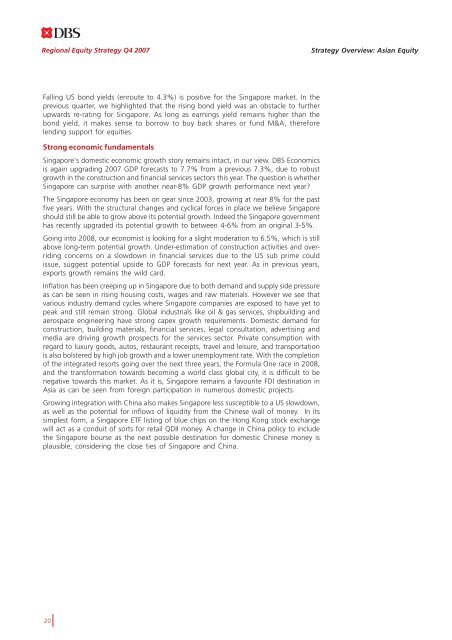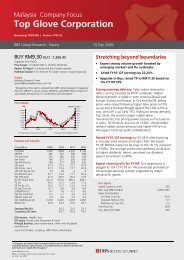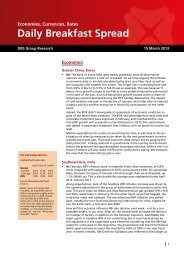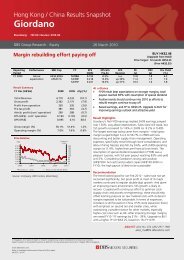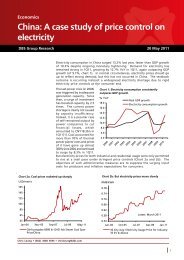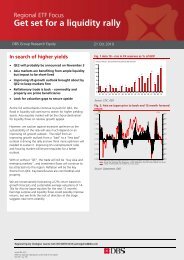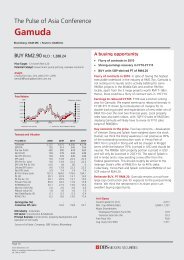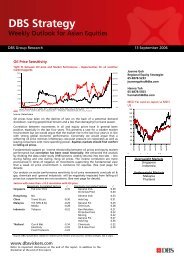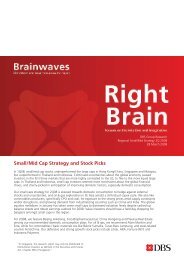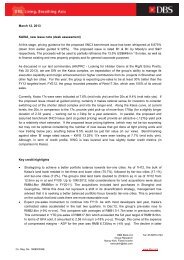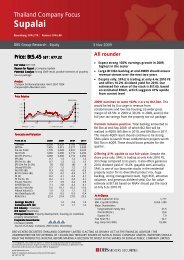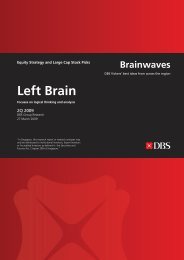Top Down Strategy and Large Cap Stock Picks - the DBS Vickers ...
Top Down Strategy and Large Cap Stock Picks - the DBS Vickers ...
Top Down Strategy and Large Cap Stock Picks - the DBS Vickers ...
Create successful ePaper yourself
Turn your PDF publications into a flip-book with our unique Google optimized e-Paper software.
Regional Equity <strong>Strategy</strong> Q4 2007<br />
<strong>Strategy</strong> Overview: Asian Equity<br />
Falling US bond yields (enroute to 4.3%) is positive for <strong>the</strong> Singapore market. In <strong>the</strong><br />
previous quarter, we highlighted that <strong>the</strong> rising bond yield was an obstacle to fur<strong>the</strong>r<br />
upwards re-rating for Singapore. As long as earnings yield remains higher than <strong>the</strong><br />
bond yield, it makes sense to borrow to buy back shares or fund M&A, <strong>the</strong>refore<br />
lending support for equities.<br />
Strong economic fundamentals<br />
Singapore's domestic economic growth story remains intact, in our view. <strong>DBS</strong> Economics<br />
is again upgrading 2007 GDP forecasts to 7.7% from a previous 7.3%, due to robust<br />
growth in <strong>the</strong> construction <strong>and</strong> financial services sectors this year. The question is whe<strong>the</strong>r<br />
Singapore can surprise with ano<strong>the</strong>r near-8% GDP growth performance next year?<br />
The Singapore economy has been on gear since 2003, growing at near 8% for <strong>the</strong> past<br />
five years. With <strong>the</strong> structural changes <strong>and</strong> cyclical forces in place we believe Singapore<br />
should still be able to grow above its potential growth. Indeed <strong>the</strong> Singapore government<br />
has recently upgraded its potential growth to between 4-6% from an original 3-5%.<br />
Going into 2008, our economist is looking for a slight moderation to 6.5%, which is still<br />
above long-term potential growth. Under-estimation of construction activities <strong>and</strong> overriding<br />
concerns on a slowdown in financial services due to <strong>the</strong> US sub prime could<br />
issue, suggest potential upside to GDP forecasts for next year. As in previous years,<br />
exports growth remains <strong>the</strong> wild card.<br />
Inflation has been creeping up in Singapore due to both dem<strong>and</strong> <strong>and</strong> supply side pressure<br />
as can be seen in rising housing costs, wages <strong>and</strong> raw materials. However we see that<br />
various industry dem<strong>and</strong> cycles where Singapore companies are exposed to have yet to<br />
peak <strong>and</strong> still remain strong. Global industrials like oil & gas services, shipbuilding <strong>and</strong><br />
aerospace engineering have strong capex growth requirements. Domestic dem<strong>and</strong> for<br />
construction, building materials, financial services, legal consultation, advertising <strong>and</strong><br />
media are driving growth prospects for <strong>the</strong> services sector. Private consumption with<br />
regard to luxury goods, autos, restaurant receipts, travel <strong>and</strong> leisure, <strong>and</strong> transportation<br />
is also bolstered by high job growth <strong>and</strong> a lower unemployment rate. With <strong>the</strong> completion<br />
of <strong>the</strong> integrated resorts going over <strong>the</strong> next three years, <strong>the</strong> Formula One race in 2008,<br />
<strong>and</strong> <strong>the</strong> transformation towards becoming a world class global city, it is difficult to be<br />
negative towards this market. As it is, Singapore remains a favourite FDI destination in<br />
Asia as can be seen from foreign participation in numerous domestic projects.<br />
Growing integration with China also makes Singapore less susceptible to a US slowdown,<br />
as well as <strong>the</strong> potential for inflows of liquidity from <strong>the</strong> Chinese wall of money. In its<br />
simplest form, a Singapore ETF listing of blue chips on <strong>the</strong> Hong Kong stock exchange<br />
will act as a conduit of sorts for retail QDII money. A change in China policy to include<br />
<strong>the</strong> Singapore bourse as <strong>the</strong> next possible destination for domestic Chinese money is<br />
plausible, considering <strong>the</strong> close ties of Singapore <strong>and</strong> China.<br />
20


